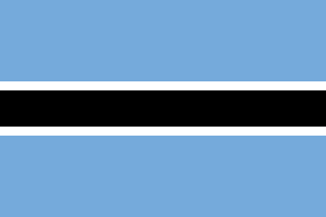 |
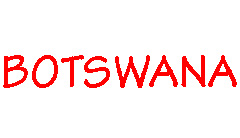 |
deel 3 |
Zondag 4 June 2017
Divundu - Kasane:
428km
Tonight we were kept awake by a cicade who made a terribly loud monotonous high pitched noise. Earbuds did not help and even my headphones did not offer 100% effect. We finally fell asleep. At 5 o'clock the animal finally shut up. Then the hippos started again, but that is much better to endure. After breakfast we drive through the Bwabata reserve to the border with Botswana. The road to the east is straight and long: over 400km. The route extends largely through the Bwabwata National Park and we are constantly warned of crossing game. For a long time we do not see any wildlife at all, but suddenly there is a Cheetah or cheetah! We are too surprised to take a picture straight away. Cheetahs are hard to find. They live alone and often in remote areas, where they have the space to hunt at high speed. We turn around, but the animal has already left. Later we see a number of antelopes and baboons.
The border crossing goes a lot slower than we hoped, because we accidentally skip the window for the Namibian exit stamp . We drive through a of no-man's land and only to be returned by the Botswana immigration officer. Without exit stamp, entry stamp. We cross for a second time through no man's land to get the stamp and back again. For the import of the car we pay N$ 220 or about 30 euros. Then we continue to Kasane, on the edge of the Chobe National Park. Here we will stay for 4 days at the Chobe Bush Lodge. Kasane and especially around our hotel is swarmed by baboons and warthogs. We book a game drive for tomorrow and a trip to the Victoria Waterfalls for Tuesday.
We dine at the hotel, which is a great pleasure. The service and the food are good.
Weather: Cloudy with occasional sunshine. Up to 27 degrees.
maandag 5
June 2017
We are keeping a slow pace in the morning. We take our laundry to the Itenge laundry. They are behind the Mandela bar, op
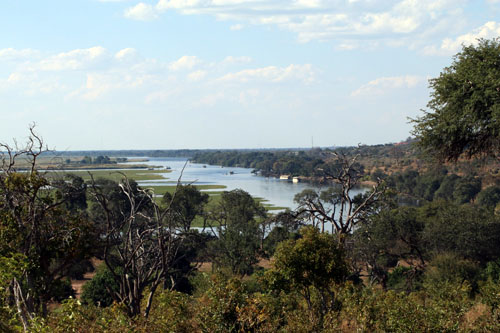 o
have coffee at the Coffee Buzz, where they serve real Capucino. The first in
many days. Next stop is the post office to mail some postcards. Next is the
Mascom store for a prepaid sim card. Mascom
is the largest mobile carrier in Botswana. We need to show a passport and
before we can be connected to Botswana's mobile network.
o
have coffee at the Coffee Buzz, where they serve real Capucino. The first in
many days. Next stop is the post office to mail some postcards. Next is the
Mascom store for a prepaid sim card. Mascom
is the largest mobile carrier in Botswana. We need to show a passport and
before we can be connected to Botswana's mobile network.We have lunch at the hotel and at 3pm we are collected for the afternoon game drive in a safari vehicle. The entrance to Chobe National Park is 4km from the lodge. Soon we see
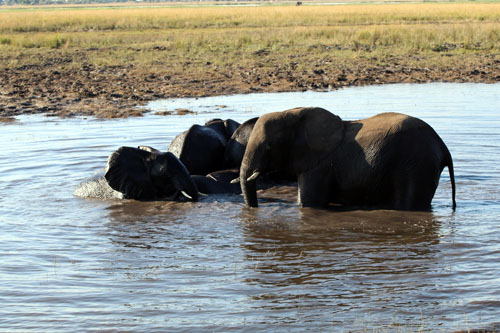 some buffalo and along the Chobe River many bathing elephants. Several
groups of elephants take a bath in the river. These are groups of male
animals. They play with each other. After the bath, they throw sand over
their backs to protect them against insects and the sun. The kudu's are also
present, but also some puku's. They are quite rare and are threatened by
extinction. They have a thicker fur, but are fairly defenseless. Impala's
are abundant here. In the distance we see buffalo on the banks of the river.
We see more elephants, but also striped mongoos. These little animals eat
the most toxic snakes. We also see the guinea fowl that appears to have very
tough meat. The African sea eagle is sitting in the tree and we also see
some vultures. Zebra's are not so abundant here. After a lot of effort we
discover three of them. At
some buffalo and along the Chobe River many bathing elephants. Several
groups of elephants take a bath in the river. These are groups of male
animals. They play with each other. After the bath, they throw sand over
their backs to protect them against insects and the sun. The kudu's are also
present, but also some puku's. They are quite rare and are threatened by
extinction. They have a thicker fur, but are fairly defenseless. Impala's
are abundant here. In the distance we see buffalo on the banks of the river.
We see more elephants, but also striped mongoos. These little animals eat
the most toxic snakes. We also see the guinea fowl that appears to have very
tough meat. The African sea eagle is sitting in the tree and we also see
some vultures. Zebra's are not so abundant here. After a lot of effort we
discover three of them. At 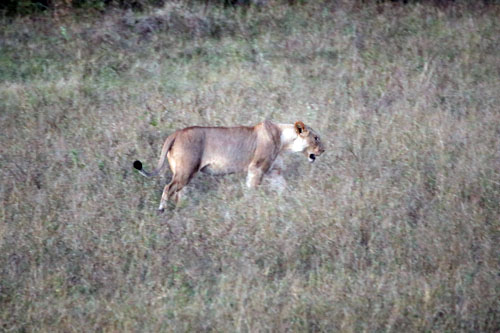 the
end of the drive, when we are already on our way to the exit, the guide
apparently receives a message via his radio about a sighting. We take a turn
and come face to face with a lonely lioness. The sun has already set, but I
can make beautiful pictures. The afternoon has been a total success.
the
end of the drive, when we are already on our way to the exit, the guide
apparently receives a message via his radio about a sighting. We take a turn
and come face to face with a lonely lioness. The sun has already set, but I
can make beautiful pictures. The afternoon has been a total success.Back in Kasane we eat at the Old House. Simple restaurant, but nicely situated in a garden. We eat burger and pizza.
Weather: Sun, 28 degrees.
Tuesday 6 June 2017
We get up early because at 7.50 our day trip to Victoria Falls in
Zimbabwe will depart. In the bus we have 12 passengers. An Australian family
of 8, a French couple an d
a Rotterdam couple. We drive first to the Zimbabwean border. That's only a
quarter of a mile. We are getting an exit stamp from the Botswana border
police without too much effort. We need to fill out a form. Then we drive to
the Zimbabwean border post. We need to get out of the bus and are met by
Tash, the Border Passage Co-ordinator of the tour organizer. He shows us the
way to the right window. We queue for about 1.5 hours . There are only two
officers available for visa applications. They are working allright, but the
procedure is cumbersome and almost entirely manual. There is a big French
group in front of us. Between stamping passports, the officials also look at
a repeat of the Champions League final. A day visa costs US$ 30 per person.
To be paid in cash and there is no change. When we are all through, we mee
d
a Rotterdam couple. We drive first to the Zimbabwean border. That's only a
quarter of a mile. We are getting an exit stamp from the Botswana border
police without too much effort. We need to fill out a form. Then we drive to
the Zimbabwean border post. We need to get out of the bus and are met by
Tash, the Border Passage Co-ordinator of the tour organizer. He shows us the
way to the right window. We queue for about 1.5 hours . There are only two
officers available for visa applications. They are working allright, but the
procedure is cumbersome and almost entirely manual. There is a big French
group in front of us. Between stamping passports, the officials also look at
a repeat of the Champions League final. A day visa costs US$ 30 per person.
To be paid in cash and there is no change. When we are all through, we mee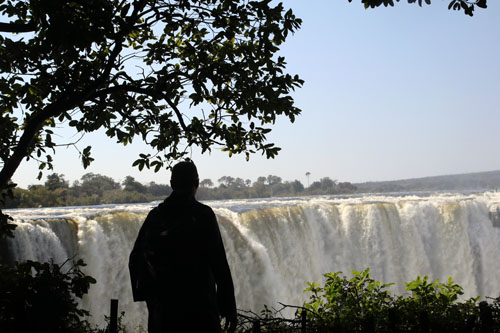 our Zimbabwean guide Smart, who is waiting for us with a Zimbabwean
bus of Shearwater tours. Victoria Falls is one hour's drive away. On the way
we see an elephant on the side of the road. Victoria Falls is a place that
is aimed entirely at tourists. We immediately drive to the waterfalls, where
we arrive at 11.30am. Smart gives a a rain poncho, because the waterfalls
are splashing quite a bit. We have booked the Guided Tour, meaning that the
guide stays with us and arranges a lunch for us. The Rotterdam couple does
this too, but have a helicopter flight at 14 o'clock. The national park is
very easy to navigate. The waterfalls are very wide and consist of 8
waterfalls. There is a walk along the shore with 16 viewing points. We go
along them one after the other. Smart tells us something about it, but we
could easily have done this without a guide. At lookout point 7, Smart goes
forward with the Rotterdammers to get them on time with the helicopter and
we have to fend for ourselves. The waterfalls are beautiful to see. The
second half is wetter. It sprays more here. It's almost fog like and the
our Zimbabwean guide Smart, who is waiting for us with a Zimbabwean
bus of Shearwater tours. Victoria Falls is one hour's drive away. On the way
we see an elephant on the side of the road. Victoria Falls is a place that
is aimed entirely at tourists. We immediately drive to the waterfalls, where
we arrive at 11.30am. Smart gives a a rain poncho, because the waterfalls
are splashing quite a bit. We have booked the Guided Tour, meaning that the
guide stays with us and arranges a lunch for us. The Rotterdam couple does
this too, but have a helicopter flight at 14 o'clock. The national park is
very easy to navigate. The waterfalls are very wide and consist of 8
waterfalls. There is a walk along the shore with 16 viewing points. We go
along them one after the other. Smart tells us something about it, but we
could easily have done this without a guide. At lookout point 7, Smart goes
forward with the Rotterdammers to get them on time with the helicopter and
we have to fend for ourselves. The waterfalls are beautiful to see. The
second half is wetter. It sprays more here. It's almost fog like and the wind is in our direction. In spite of the ponchos we get pretty wet
pants and the shoes. Making photos is no longer possible and you can not see
much because of the fog either. We walk to the view to the bridge over the
Zambezi. This is also the border post with Zambia. Bunjee jumping is offered
on the bridge. We watch it, from a relatively dry position. We walk back to
the exit and run into Smart again. We walk through the rainforest to the
exit. We have lunch at the Rainforest Café. The food is not so bad. After
lunch, Smart brings us to the open Craft Market. The other guests are also
coming along. We are being ambushed by sellers who are very active selling
there handicraft to a point it gets anoying. They even want to trade their
wood carvings for clothes like a hat, socks or shoes. There is a hall where
only women are selling. Those are a little less obnoxious but try to work on
our sentiments. We buy a bowl for 3 dollars. Then we go for a drink. I take
a looki around the corner at another Craft Mall and there is a very
different atmosphere. You can look around quietly without anyone bothering
you. We should have gone there right away.
wind is in our direction. In spite of the ponchos we get pretty wet
pants and the shoes. Making photos is no longer possible and you can not see
much because of the fog either. We walk to the view to the bridge over the
Zambezi. This is also the border post with Zambia. Bunjee jumping is offered
on the bridge. We watch it, from a relatively dry position. We walk back to
the exit and run into Smart again. We walk through the rainforest to the
exit. We have lunch at the Rainforest Café. The food is not so bad. After
lunch, Smart brings us to the open Craft Market. The other guests are also
coming along. We are being ambushed by sellers who are very active selling
there handicraft to a point it gets anoying. They even want to trade their
wood carvings for clothes like a hat, socks or shoes. There is a hall where
only women are selling. Those are a little less obnoxious but try to work on
our sentiments. We buy a bowl for 3 dollars. Then we go for a drink. I take
a looki around the corner at another Craft Mall and there is a very
different atmosphere. You can look around quietly without anyone bothering
you. We should have gone there right away.
All in all, we would have been better off with transport only. That would
have been US$95 pp and we paid $212.
At 15.20 we go back to the border again. The exit is extremely smooth. We
get our stamps and within 10 minutes we are through both border posts. Then
another fifteen minutes and we are at the lodge at 16.40.
In the evening we eat at an Indian restaurant PPCC. The food tastes
excellent. The serves leaves room for improvement.
Weather: early cloudy, but later sunny. About 21 degrees.
Thursday 7 June 2017
After breakfast we have to do some shopping. Then drink coff
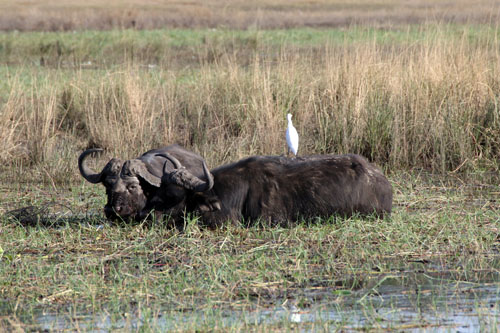 ee
at Coffee Buzz. A large group of Messiah College students come in to drink
coffee and discuss their journey. We take Capucino and Erik a rosewood pie,
which turns out to be huge. Then we want to go to the Shell gas station, but
they out of Diesel. We have to drive 4 kilometers to the Puma station, where
they have plenty. From there we drive to the Choppies to get gro
ee
at Coffee Buzz. A large group of Messiah College students come in to drink
coffee and discuss their journey. We take Capucino and Erik a rosewood pie,
which turns out to be huge. Then we want to go to the Shell gas station, but
they out of Diesel. We have to drive 4 kilometers to the Puma station, where
they have plenty. From there we drive to the Choppies to get gro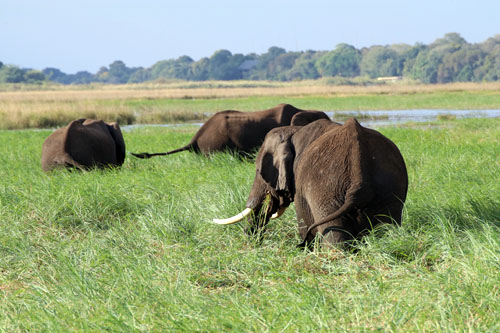 htime.
We lunch on the hotel's terrace and at three o'clock we go across the road
to the Chobe Safari Lodge for the Sunset River Cruise. It's a big boat with
which we go up the Chobe River. We see elephants, crocodiles, hippos,
kudu's, lechwe's (very rare antelope species), water buffalo, african
skimmers (extinction threatened, spoonbills, storks, iguana, african osprey
and many other species. Finished with a be
htime.
We lunch on the hotel's terrace and at three o'clock we go across the road
to the Chobe Safari Lodge for the Sunset River Cruise. It's a big boat with
which we go up the Chobe River. We see elephants, crocodiles, hippos,
kudu's, lechwe's (very rare antelope species), water buffalo, african
skimmers (extinction threatened, spoonbills, storks, iguana, african osprey
and many other species. Finished with a be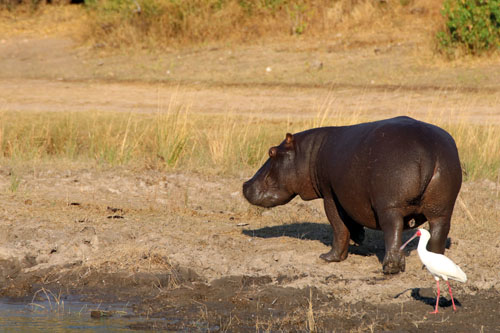 autiful
sunset on the Namibian horizon The Chobe River is the border between the two
countries. The guide is very informative. We are seated at the front of the
boat and have great views. There is also a top deck where a limited number
of passengers can stand at the same time, but that's not worth the effort.
autiful
sunset on the Namibian horizon The Chobe River is the border between the two
countries. The guide is very informative. We are seated at the front of the
boat and have great views. There is also a top deck where a limited number
of passengers can stand at the same time, but that's not worth the effort.We dine at the hotel's restaurant. The food is delicious again. Special of the day is Impala chops. Erik takes sirloin steak. The wine is a Hill & Dale Shiraz 2014 from South Africa.
Weather: Cloudy start, but it's clearing up. 24⁰C
Thursday 8 June 2017
Kasane - Maun: 320km, 4:10 uur
Today we drive to Nata, more than 300 km to the south. The road ru ns
approximately parallel to the border with Zimbabwe. There is only one small
village on the route. We arrive at Nata around 12 o'clock. The village does
not amount to much. The Nata Lodge is 8km south and owned the same company
as the lodge in Kasane. Much smaller though. We have a cottage on poles with
a large room and an outdoor shower. We have lunch and laze about at the
pool, far too cold to take a swim. At 4
ns
approximately parallel to the border with Zimbabwe. There is only one small
village on the route. We arrive at Nata around 12 o'clock. The village does
not amount to much. The Nata Lodge is 8km south and owned the same company
as the lodge in Kasane. Much smaller though. We have a cottage on poles with
a large room and an outdoor shower. We have lunch and laze about at the
pool, far too cold to take a swim. At 4 pm
we go on the Pan Drive to the Sua Pan in the Nata Sanctuary, where many
birds can be spotted. We see Northern Black Korhaan, Southern Crowned
Cranes, a Double Banded Courser and pelicans. We see, while enjoying a
drink, a beautiful sunset over the water of the Sua Pan. When the sun is
under the sky, the sky turns red and it is time to go back over the sandy
roads of the sanctuary and then over the paved road with many deep potholes.
Around seven we are back in the hotel. We dine at the hotel
restaurant. The portions are generous. Too generous for us. The quality
moderate.
pm
we go on the Pan Drive to the Sua Pan in the Nata Sanctuary, where many
birds can be spotted. We see Northern Black Korhaan, Southern Crowned
Cranes, a Double Banded Courser and pelicans. We see, while enjoying a
drink, a beautiful sunset over the water of the Sua Pan. When the sun is
under the sky, the sky turns red and it is time to go back over the sandy
roads of the sanctuary and then over the paved road with many deep potholes.
Around seven we are back in the hotel. We dine at the hotel
restaurant. The portions are generous. Too generous for us. The quality
moderate.
Weather: sunny 25 degrees. At night it cools down to 12 degrees
Friday 9 June 2017
Nata - Maun: 300km, 3,5 hrs
We wake up in the icy cold room. Under the blankets it was nice and warm,
but the botswana nights are cold. We have to shower in an outdoor shower.
Nice when the weather is hot, but now it is a bit of a challenge. Although
... the water is hot. After breakfast we drive towards Maun (pronounced:
Ma-oen). However, in Nata we see a sign telling us that the road is closed.
But how do we get to Maun? We ask the locals and they say you can drive
there, but you have to take a diversion. The road is very bad. Terrible with
many and very big potholes. After about 40km it becomes very bad and we spot
a tiny sign saying deviation. We take the turn off and get on a sand road
leading to a gravel road. This one runs parallel to the A3 and we follow it
for 20 minutes until we reach a village. Here the road is tarred and we turn
right onto the A3. The road is a bit better, but still very bad. After 200km
we arrive at a checkpoint where a police officer asks for our origin and
destination. We can drive after a short chat. Then there is a sign that we
must drive carefully because of the uneven road surface. Better late than
never. We arrive at Maun around 12 o'clock. We drive first to the DNWP, the
government organization that runs national parks to get a permit for
tomorrow, so that we can drive through the Moreni Wildlife Reserve. Then we
continue to the Sedia Riverside Hotel.
The hotel is located 8 km north of Maun. It's not to bad, but quite worn and
tired. The wifi is very good though.
In the afternoon we do some shopping and laze at the pool. In the evening we
want to eat at the Sportsbar, but it turns out to be closed. French
Connection is not open in the evening and Bonne Arrivee no longer exists. We
then end up at Capello opposite the airport. A kind of cocktail bar annex
nightclub which also works as a restaurant. The service is very friendly,
but the food is moderate.
Back to the hotel.
Weather: sunny 28 degrees.
Saturday 10 June 2017
Maun - Khwai:
124km, 3 hrs
Today we drive to Khwai Guest
House just outside the Moreni Wildlife Reserve. It is on the other
northern side. So we have to go through the Reserve to get there. We bought
a transit permit at the DNWP office in Maun yesterday, but we realise that
this is only valid for one way. We return to the DNWP. There they tell us
that we can also pay at  the
gate itself. This delay has cost us an hour. Then on our way to the South
Gate of Moreni. The first 30km of the road is tarred, but it becomes gravel
after that. After 50km we reach the Vetenerary checkpoint, but that amount
to very little. We are kindly waved through. Further on we turn left towards
Moreni and the road becomes bumpier and sandier. We cannot go faster than
35km/h. We do encounter wild animals. A large group of elephants is drinking
and bathing at a large pool and we also see a quartet of giraffes eating
from the trees. We arrive at the South Gate. Here we have to enroll yet
again in the big book before we can go to Khwai for the last 30km. The road
is very sandy here and we do around 30km/h through the reserve. At the North
Gate we leave the r
the
gate itself. This delay has cost us an hour. Then on our way to the South
Gate of Moreni. The first 30km of the road is tarred, but it becomes gravel
after that. After 50km we reach the Vetenerary checkpoint, but that amount
to very little. We are kindly waved through. Further on we turn left towards
Moreni and the road becomes bumpier and sandier. We cannot go faster than
35km/h. We do encounter wild animals. A large group of elephants is drinking
and bathing at a large pool and we also see a quartet of giraffes eating
from the trees. We arrive at the South Gate. Here we have to enroll yet
again in the big book before we can go to Khwai for the last 30km. The road
is very sandy here and we do around 30km/h through the reserve. At the North
Gate we leave the r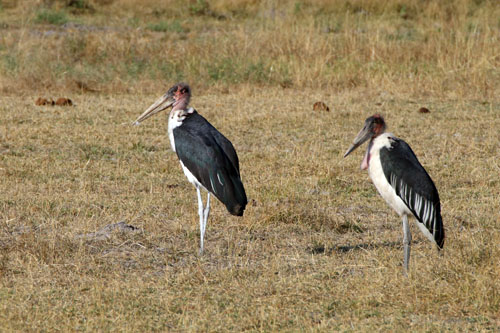 eserve
over a wooden bridge. Then it's a short distance to Khwai village and the
Khwai Guest House. We are welcomed by Ruben, who has the overall lead here.
He is very friendly. The layout of the Guest House is simple, but it has
good quality. There are 5 chalets with double bed, toilet and outdoor
shower. In the central building there is a dining room and lounge where you
can eat under a roof, but in the open air or have a drink. We have booked
full board and two activities. An afternoon game drive from 15.30 to 19.30
and a morning game drive from 7 to 10.30.
eserve
over a wooden bridge. Then it's a short distance to Khwai village and the
Khwai Guest House. We are welcomed by Ruben, who has the overall lead here.
He is very friendly. The layout of the Guest House is simple, but it has
good quality. There are 5 chalets with double bed, toilet and outdoor
shower. In the central building there is a dining room and lounge where you
can eat under a roof, but in the open air or have a drink. We have booked
full board and two activities. An afternoon game drive from 15.30 to 19.30
and a morning game drive from 7 to 10.30.
We have 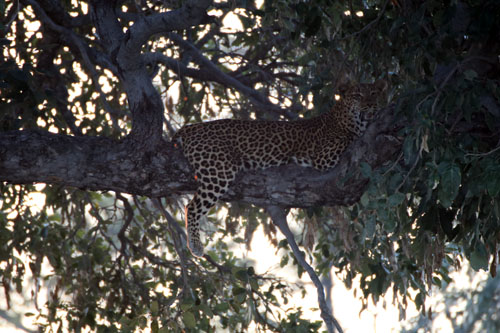 lunch
from the traditional buffet and take a rest in our room. At half past four
we leave for the game drive. It starts easily with game we already know
well: vultures, zebras, impala's. We see a dead elephant, who gets full
attention of the of the vultures. They are joined by Marabou storks. Ugly
birds, regarded to be one of the ugly five, together with vultures, hyenas,
warthogs and the gnoe. Next we will see a number of elephants, herons, Cape
vultures, copper tail coucal, spurwinged geese, egrets, sunbirds,
crocodiles, vervet monkeys and hippos. But that all is dwarved by
what we get to see just before the end. In a tree lies a leopard on a
branch! This big cat rarely shows itself. He lives solitary and is very shy.
He sees humans long before we see him and then he is usually
gone. But this one is beautiful. After a while he gets up, climbs down the
tree and walks off. We are following it for a bit. He does not seem to be
disturbed by the car with 8 guests. He just looks past us. After a while he
disappears in the bushes and we leave him alone.
lunch
from the traditional buffet and take a rest in our room. At half past four
we leave for the game drive. It starts easily with game we already know
well: vultures, zebras, impala's. We see a dead elephant, who gets full
attention of the of the vultures. They are joined by Marabou storks. Ugly
birds, regarded to be one of the ugly five, together with vultures, hyenas,
warthogs and the gnoe. Next we will see a number of elephants, herons, Cape
vultures, copper tail coucal, spurwinged geese, egrets, sunbirds,
crocodiles, vervet monkeys and hippos. But that all is dwarved by
what we get to see just before the end. In a tree lies a leopard on a
branch! This big cat rarely shows itself. He lives solitary and is very shy.
He sees humans long before we see him and then he is usually
gone. But this one is beautiful. After a while he gets up, climbs down the
tree and walks off. We are following it for a bit. He does not seem to be
disturbed by the car with 8 guests. He just looks past us. After a while he
disappears in the bushes and we leave him alone.
Afterwards we enjoy a sunset at a pond in which some hippos swim. We enjoy
it with a drink. When it gets dark we enter the car and the hippos come out
of the water. They show us that they do not apreciate our presence by
opening their mouths wide open showing their deadly teeth. We are going back
to the guest house.
There we will eat a meal of rice and chicken, cooked in a steel pan (Dutch
Oven) on a wood fire. After dinner we go to bed early. It's getting cold,
but under warm blankets it's nice.
Weather: sunny 26 degrees
Sunday 11 June 2017
Khwai - Maun: 124km, 3,5 uur.
We are woken up at 6 o'clock. Breakfast is at half past six and at 7am we
leave for the morning drive. We soon see a waterbuck. An antelope species
with a charac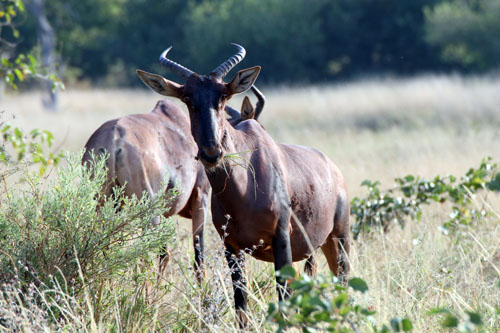 teristic
white circle on its behind. It resembles a toilet seat. High in a tree is
the African Sea Eagle. We drive for a while without seeing anything. That is
when we encounter on a group of vervet monkies. Above them a family of
baboons. The head baboon tries to intimidate us a little. The marabous are
also present again. We also see two wattled cranes. These are seriously
threatened because too many have been hunted in the past. It is the largest
crane bird species of Africa and the second largest in the world. They rise
to 1.72m high.
teristic
white circle on its behind. It resembles a toilet seat. High in a tree is
the African Sea Eagle. We drive for a while without seeing anything. That is
when we encounter on a group of vervet monkies. Above them a family of
baboons. The head baboon tries to intimidate us a little. The marabous are
also present again. We also see two wattled cranes. These are seriously
threatened because too many have been hunted in the past. It is the largest
crane bird species of Africa and the second largest in the world. They rise
to 1.72m high.
Then we see another group of antelopes, which we have not seen yet: the
Tsesebe. They have high shoulders and a short neck. They are very muscular
and are said to walk very fast. We also see a group of red Lechwe waterboks.
They usually stay by the water because they like plants that grow in or ne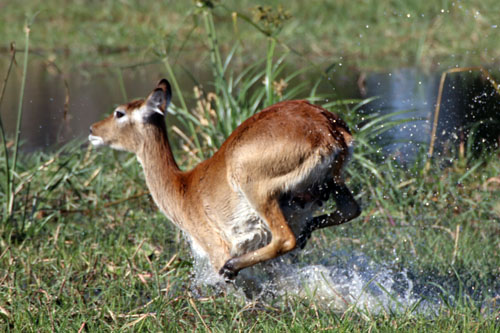 ar
it. We break for coffee at a lake before we go back. On our way to the
Guest House, we are pointed two leopard cubs by a South African couple. But
we can not see them well.
ar
it. We break for coffee at a lake before we go back. On our way to the
Guest House, we are pointed two leopard cubs by a South African couple. But
we can not see them well.
Back at the guest house we take our belongings, we pay the bill and go to
Maun. We know the way, but it's still quite a journey. On the way we see
elephants and giraffes as well as groups of zebras. A driver who drives
towards us points to vultures circling around a dead giraffe. We see the
vultures, but they are too far off the road to get to them.
In Maun we check in at the Island
Safari Lodge. Beautifully located by the river, but a bit outdated. The
restaurant is very disappointing. The beds are short and there is no
mosquito net. The staff is very friendly though.
Weather: in the morning very cold, 12 degrees. It warms up to 28 degrees.
Monday 12 June 2017
We get up early: at 6.30 am the alarm clock sounds. We have breakfast at
the restaurant. The breakfast is surprisingly complete and good. After breakfast we wait at the jetty for the
skipper, who will take us to the Mokoro central. There is some delay because
two outside guests are late. When arrive - and had their coffee - we
can take the motorboat to Boro where the polers live. Polers are the people
who navigate the flat boats into the Okavango Delta. The boat trip to Boro
takes 45 minutes, but it is very cold. It's only 12 degrees and the boat is
quite fast. We get a blanket to shield us from the cold air. The polers have
formed a collective and, take turns performing the mokoro tours into the
concession area NG32. In this way, the revenue from the tours fully benefits
the Boro community. African Secrets has given
surprisingly complete and good. After breakfast we wait at the jetty for the
skipper, who will take us to the Mokoro central. There is some delay because
two outside guests are late. When arrive - and had their coffee - we
can take the motorboat to Boro where the polers live. Polers are the people
who navigate the flat boats into the Okavango Delta. The boat trip to Boro
takes 45 minutes, but it is very cold. It's only 12 degrees and the boat is
quite fast. We get a blanket to shield us from the cold air. The polers have
formed a collective and, take turns performing the mokoro tours into the
concession area NG32. In this way, the revenue from the tours fully benefits
the Boro community. African Secrets has given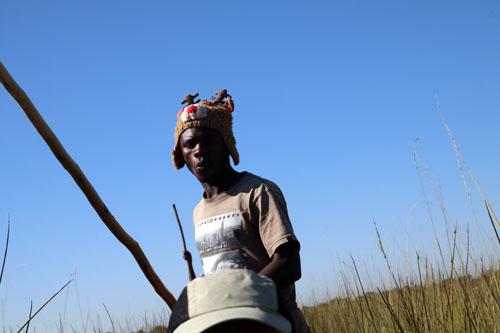 us lunch package and a liter of water. Our poler today is called Ronnie. His
colleague is Kenny. Kenny takes the other two (German) guests. We glide
through the reed of the Okavango Delta. First a bit through the main canal,
and then through very narrow sideways. We glide through different types of
reed and see a lot of water lilies that are just opening up to the daylight.
After an hour and a half we arrive at an island where we go on land. After a
brief briefing from Ronnie, we are heading for a walk of more than 2 hours.
Ronnie has a knitted hat that is meant for Christmas (reindeer horns and a
red nose). The sun is at its peak - it's already twelve o'clock - and
there's no shadow. Ronnie leads us along a Lead Wood Tree and a palm tree.
He tells about the preparation of the palm wine. In the distance we see
elephants, giraffes, zebras and gnomes. Ronnie points them all out and tells
about them. Each time he ends with "Any questions? Thank you for listen
us lunch package and a liter of water. Our poler today is called Ronnie. His
colleague is Kenny. Kenny takes the other two (German) guests. We glide
through the reed of the Okavango Delta. First a bit through the main canal,
and then through very narrow sideways. We glide through different types of
reed and see a lot of water lilies that are just opening up to the daylight.
After an hour and a half we arrive at an island where we go on land. After a
brief briefing from Ronnie, we are heading for a walk of more than 2 hours.
Ronnie has a knitted hat that is meant for Christmas (reindeer horns and a
red nose). The sun is at its peak - it's already twelve o'clock - and
there's no shadow. Ronnie leads us along a Lead Wood Tree and a palm tree.
He tells about the preparation of the palm wine. In the distance we see
elephants, giraffes, zebras and gnomes. Ronnie points them all out and tells
about them. Each time he ends with "Any questions? Thank you for listen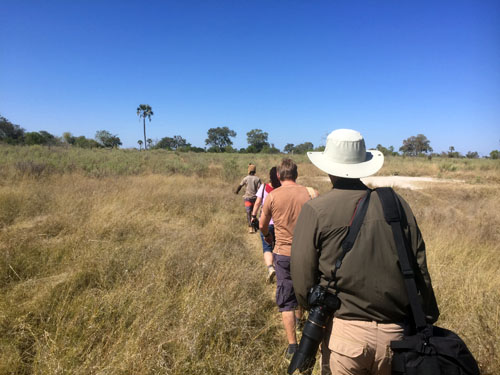 ing".
These animals take to these islands to get out reach of the lions . But the
lions can also cross the water and we find the tracks of lions as proof of
that. We are happy when the walk is over and we can have lunch in the shade
of a Lead wood tree. We are joined by a British couple living in South
Africa. After half an hour we ready for the return journey. In about an hour
we return to Boro. There we are awaited by the motorboat skipper, who takes
us back to the Island Safari Lodge. On the way we stop to see a large
crocodile.
ing".
These animals take to these islands to get out reach of the lions . But the
lions can also cross the water and we find the tracks of lions as proof of
that. We are happy when the walk is over and we can have lunch in the shade
of a Lead wood tree. We are joined by a British couple living in South
Africa. After half an hour we ready for the return journey. In about an hour
we return to Boro. There we are awaited by the motorboat skipper, who takes
us back to the Island Safari Lodge. On the way we stop to see a large
crocodile.
In the evening we eat at the
Thamakalane Lodge. The food in our own lodge was abominable and we want
to eat something good now. It's a buffet dinner, but a very good one. We eat
delicious food overlooking the river. Then we drive through total darkness
to our lodge.
Weather: cold in the morning, but around the 28 degrees in the sun.
dinsdag 13 June 2017
Maun - Ghanzi: 285km, 3 hours
We drive from the lodge to Maun, where we refuel at Engen gas station.
Then we drive in one straight line to Ghanzi in the Kalahari Desert.
It's actually not a desert but a semi-desert because it's raining a lot more
than in desert areas. It is also green everywhere. There is grass, but also
bushes and trees. Here and there there are also lakes and rivers. It is very
empty. We see only up to 3 or 4 villages over a ride of almost 300km. We
come pass two checkpoints, where we are checked for food and going through a
disinfectant bath with the shoes and the car. After 3 hours we arrive in
Ghanzi. It is a town and regional center, with many supermarkets and cheap
clothing stores. In the middle of the village is the
Kalahari Arms hotel. We
have a spacious (family) room in a round chalet near the large pool. We
first eat at the restaurant. I'm taking a Russian with fries. That's a
sausage with a dry crust. After that we have a rest and then we explore the
shops. We do some shopping at the Spar and visit the cultural center of the
San people (bushmen) where we buy a souvenir.
The afternoon we spend relaxing at the pool. We're going in too, but it's
cold. Not too cold to swim some strokes. We drink a beer that we bought at
the neighboring liquor store.
In the evening we eat at the hotel restaurant. The food is not bad at all.
Erik takes a mushroom soup and then beef. I have a shrimp cocktail (very
small prawns) and a Delta bream.
Weather: in the morning 11 ° C. It then warms up to 26 °.
|
|
Other Travel |
|
| back | continue |